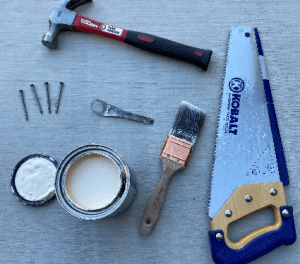Introduction
Additive manufacturing (AM) is an advanced manufacturing system with a transformative approach to production that enables the creation of lighter as well as stronger parts and systems. In recent years, AM has attracted worldwide attention as an emerging process of making complex three-dimensional objects in various applications within industries such as healthcare, biomedical, aerospace, textile, food and construction. What AM ultimately does is build 3D objects by adding layer by layer of material. The aim of this article is to review the various 3D printing industries in the Indian landscape with a focus on adoption strategies.

Fig. 1 : 3D printer at CIPET : School for Advanced Research in Petrochemicals (SARP) – ARSTPS,Chennai
3D Printing: It’s All About the Printer
When the Massachusetts Institute of Technology (MIT) invented binder jet printing in the 1980s, they wrote “three-dimensional printing is a process under development at MIT for the rapid and flexible production of prototype parts, end-use parts, and tools directly from a CAD model.”
Today our concept of “3D printing” is much broader, but the term is often associated with filament-based plastic printers, which are the pride and joy of many a hobbyist and self-described maker. But there are also binder jet printers, laser metal 3D printers, as well as glass and clay 3D printers. Whatever the kind of printer, the term “3D printing” looks to the printer itself, and the full range of technologies that can build an object from a CAD file. How big of a part can it print? In what materials, and and how fast? Is the printer filament, resin, or powder-based? Thinking about 3D printers and “3D printing” brings all of these questions to mind.
Additive Manufacturing: A Bytes-to-Parts Supply Chain
“Additive manufacturing” (AM) is a big picture term more at home in the boardroom than the factory floor or garage. Think of AM as the industrial version of 3D printing according to author Dave Turbide. Naturally, AM separates itself from older, subtractive technologies like milling. Otherwise, the term is less about the 3D printer itself, and more about the manufacturing process transformed by 3D printing.
What is that transformation? AM changes the way we think about inventory and supply chain, taking parts from the point of manufacture to the point of use.
AM is flexible in the time it takes to load a file, from anywhere in the world. It enables customized parts, in volume, and involves stocking raw materials like filament and printing spare parts on demand. Additive technologies enable designs that are not possible with subtractive manufacturing techniques, like hollow designs with infill or topological optimized designs. In that way, AM is about taking all of the design and production possibilities of 3D printing and applying them to engineering, manufacturing, and supply chains.
3D Printing Technologies
There are three broad types of 3D printing technologies; sintering, melting, and stereolithography.
- Sintering is a technology where the material is heated, but not to the point of melting, to create high-resolution items. Metal powder is used for direct metal laser sintering while thermoplastic powders are used for selective laser sintering.
- Melting methods of 3D printing include powder bed fusion, electron beam melting and direct energy deposition. These use lasers, electric arcs or electron beams to print objects by melting the materials together at high temperatures.
- Stereolithography utilises photopolymerization to create parts. This technology uses the correct light source to interact with the material in a selective manner to cure and solidify a cross-section of the object in thin layers.

VAT polymerization




3D Printed parts of Plastic Grabber
In 2018, I designed & fabricated a Plastic Grabber for a project of UNDP (United Nations Development Programme) using FDM 3D Printer using ABS material. 3 D Printing was found to be efficient with least wastage & least error.
The advantages of using 3D printing include the following:
- Bespoke, cost-effective creation of complex geometries:
This technology allows for the easy creation of bespoke geometric parts where added complexity comes at no extra cost. In some instances, 3D printing is cheaper than subtractive production methods as no extra material is used. - Affordable start-up costs:
Since no moulds are required, the costs associated with this manufacturing process are relatively low. The cost of a part is directly related to the amount of material used, the time taken to build the part and any post-processing that may be required. - Completely customizable:
Because the process is based upon computer aided designs (CAD), any product alterations are easy to make without impacting the manufacturing cost. - Ideal for rapid prototyping:
Because the technology allows for small batches and in-house production, this process is ideal for prototyping, which means that products can be created faster than with more traditional manufacturing techniques, and without the reliance on external supply chains. - Allows for the creation of parts with specific properties:
Although plastics and metals are the most common materials used in 3D printing, there is also scope for creating parts from specially tailored materials with desired properties. So, for example, parts can be created with high heat resistance, water repellency or higher strengths for specific applications.
The disadvantages of 3D printing include the following:
- Can have lower strength than traditional manufacturing:
While some parts, such as those made from metal, have excellent mechanical properties, many other 3D printed parts are more brittle than those created by traditional manufacturing techniques. This is because the parts are built up layer-by-layer, which reduces the strength by between 10 and 50%. - Increased cost at high volume:
Large production runs are more expensive with 3D printing as economies of scale do not impact this process as they do with other traditional methods. Estimates suggest that when making a direct comparison for identical parts, 3D printing is less cost effective than CNC machining or injection moulding in excess of 100 units, provided the parts can be manufactured by conventional means. - Limitations in accuracy:
The accuracy of a printed part depends on the type of machine and/or process used. Some desktop printers have lower tolerances than other printers, meaning that the final parts may slightly differ from the designs. While this can be fixed with post-processing, it must be considered that 3D printed parts may not always be exact. - Post-processing requirements:
Most 3D printed parts require some form of post-processing. This may be sanding or smoothing to create a required finish, the removal of support struts which allow the materials to be built up into the designated shape, heat treatment to achieve specific material properties or final machining.
India 3D Printing market
3D printing is relatively a new entrant to the Indian industry. But, in the past few years, many innovative 3D printers have been launched in the Indian market to increase their popularity and usage among people. 3D printing technology has gained a lot of momentum in the country over the past few years, with several government initiatives, launched to encourage young entrepreneurs and innovators to embrace additive manufacturing technology. According to reports, the 3D printing Indian market is growing at 20% every year. It is expected that the 3D printing market will jump from $12.6 billion (in 2020) to $37.2 billion in 2026. Some of the key industries that will be the biggest beneficiaries of this technology are automotive, electronics, healthcare, and aerospace. On this note, let’s look at the future trends of the 3D printing solution in India that will bring a massive transformation.
Focus on made-in-India 3D printers:
The Indian government has been providing a lot of support to the Indian 3D printing industry. It includes offering subsidies and tax relief on some of the products. As a result, we will see made-in-India 3D printers on the market in the upcoming years. Made in India, 3D printers will be cost-effective while offering top-notch features. As a result, more people will be opt for these Indian 3D printers, which will ultimately lead to massive growth in this sector. As the printers will be made locally, small-scale businesses will purchase them without worrying about the delivery time or paying extra money. As a result, it will help save plenty of production costs while allowing companies to cut down their overhead expenditure.
Growth of metal 3D printing in India:
India is not new to metal 3D printing. Industries use metal 3D printers for the large-scale production of parts made out of steel, titanium, and aluminium. However, the cost of these machines is relatively high. That’s why it is essential to focus on building 3D printed metal in India. Several vital companies are already investing in this sector to enter mass production soon. The aim is not just to reduce the overall production time, but also cut down the total operational costs by a considerable margin. In 2022 and beyond, we will see more applications of metal 3d printing in the automotive, aerospace, and healthcare industries. It will open up several new opportunities to build prototypes, rapid tooling, functional parts manufacturing, and more. Several large-scale steel and aluminium manufacturing companies are collaborating with 3D printing companies to stay competitive in the global markets.
Using 3D printing in R & D
Research and development is an essential department of every industry. New technologies are being used to research, test, and develop several products before they hit the market. 3D printing has become one of the viable options for research & development departments over the past few years. It provides quick access to numerous designs without any additional cost.
In 2022, we will see more applications of 3d printing in the R&D departments across India. For example, it will help engineers build several prototypes, make changes based on design testing, and get more insights into product testing before finalizing production plans. In addition, as the R & D becomes affordable, we will see several new products being introduced in the market from India.
More applications in education:
3D printing in India has already made its presence felt in the education sector. Several schools and universities are using 3D printers to teach students about additive manufacturing. They get access to several designs and learn about the process of production at an early stage in their careers.
Industries set for growth in the use of 3D printing in 2022
Below are some key industries that will integrate more 3D printing applications in 2022:
Automobile:
The automotive industry in India is growing at a rapid pace. Several international companies are expanding their presence in the Indian market to sell more vehicles than ever before. With increasing demand, the need for 3D printed parts will also increase in 2022.
Electronics:
Several parts can be manufactured using 3D printing technology in electronic industries. These include connectors, brackets, valves, sensors, and more. As a result, it has become quite popular among several electronics giants looking at new opportunities to get ahead of the competition.
Healthcare:
3D printing in healthcare is a new trend in India that will gather more momentum in 2022. Several applications of 3D printing technology have already been used in the medical industry to create custom-made implants, models, and other tools for surgical purposes. Several companies are working on this technology to reduce the cost of treatment by cutting down recovery times significantly.
Aerospace:
The Indian aerospace industry is one of the most extensive areas that will increase additive manufacturing use in 2022. Several companies are already investing in metal 3D printing machines to manufacture parts at a lower cost for planes and automobiles.
Defence:
The Defence industry is one of the essential industries in India that will adopt 3D printing on a larger scale in 2022. Not only does it help to develop new weapons faster, but it also cuts down production costs significantly. Moreover, it will remove foreign companies’ dependency on machinery and help the country with a significant competitive advantage over its geopolitical rivals.
Others:
3d printing technology is not just limited to these industries. Several other areas such as sports, footwear, jewellery, toys, communication equipment, construction & architecture will see increased use of additive manufacturing in 2022. The future of 3d printing in India is bright as it has a lot of potential to revolutionize several other industries. As a result, we will see a surge in 3d printing services across multiple Indian industries.
Government of India’s Plan and Goals for 3D Printing
The Ministry of Electronics and Information Technology (MeitY) under Government of India had released a national strategy for additive manufacturing (commonly known as 3D printing) on 25.05.2022 to encourage collaboration between academia, government and industry with the goal of making India a global hub for design, development and deployment of 3D printing.
Mr. Ashwini Vaishnaw, Minister of Railways, Communications, Electronics and Information Technology outlined that the goal is to produce 50 India-specific technologies, 100 new startups, 500 products, 10 existing and new manufacturing sectors and 1 lakh new skilled workers. He hopes additive manufacturing becomes a major export item in the coming years.
Without an effort to build indigenous strength can result in a situation where material, printers and design will continue to come from outside and the country ends up paying large amounts of royalty to foreign companies. India has missed the bus on high precision manufacturing, but India is at the same stage as the rest of the world in this sector. Additive manufacturing plays to the strengths that India has, which is software, electronics, ESDM and artificial intelligence (AI) according to Mr. Rajeev Chandrasekhar, Minister of state, MeitY.
One of the objectives of the strategy is to enhance India’s position in the global 3D manufacturing landscape– achieve a market share of 5% and contribute nearly $1 billion to the GDP by 2025. The global 3D printing products and services market was valued at $12.6 billion in 2020 and is expected to grow at a compound annual growth rate (CAGR) of 17% between 2020 and 2023, according to Statista, a market research firm.3 D Printing future:
- 3D printing will become a mainstream technology for serial production
- Design software for additives will become more integrated and easier to use
- Focusing on education will enable more 3D printing applications and adoption
- Dental will adopt 3D printing as a dominant production technology
- 3D printing will become smarter
- The 3D printing service bureau market will continue to expand
- Metal 3D printing will continue to mature
- Composite 3D printing will offer a huge market opportunity
- Automation will become a key focus for the industry
- The additive manufacturing landscape will become more competitive
- Trends signal a bright future for AM
References for 3D Printing Technology
- Additive Manufacturing Technologies, Rapid Prototyping to Direct Digital Manufacturing (Springer) by Gibson, D.W. Rosen, B. Stucker
- Additive Manufacturing: 3D Printing for Prototyping and Manufacturing (Hanser) by Andreas Gebhardt and Jan-Steffen Hötter
- 3D Printing and Additive Manufacturing, Principles and Applications (World Scientific) by Chee Kai Chua and Kah Fai Leong
- Additive Manufacturing – A Tool for Industrial Revolution 4.0 (Elsevier ) by M. Manjaiah, K. Raghavendra, N. Balashanmugam, J. Paulo Davim
- https://manufactur3dmag.com/
- https://all3dp.com/
- https://www.3dbeginners.com/





